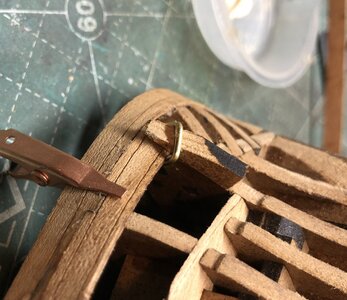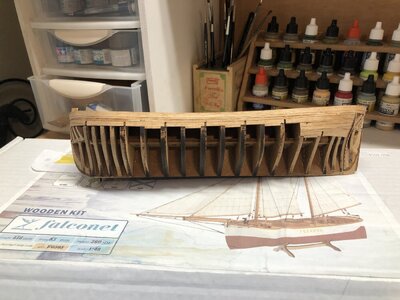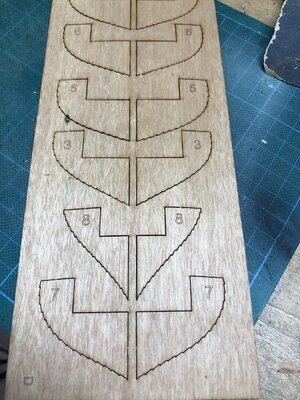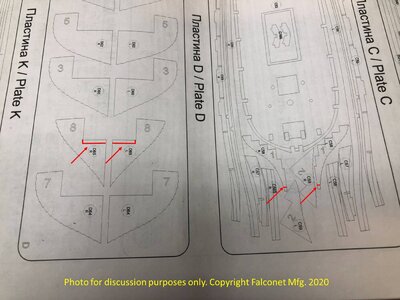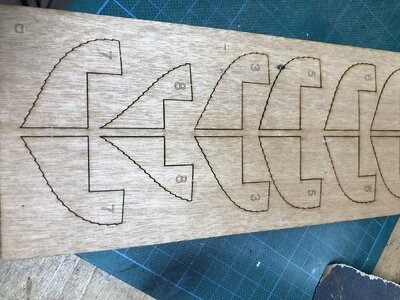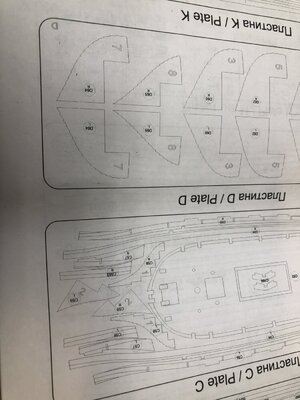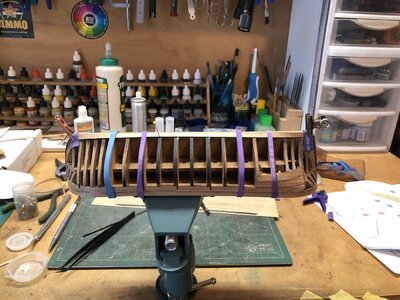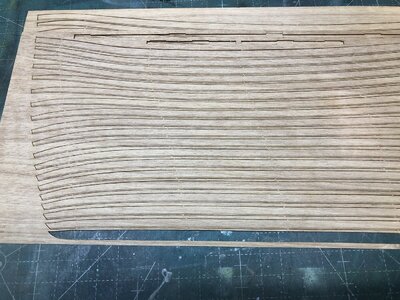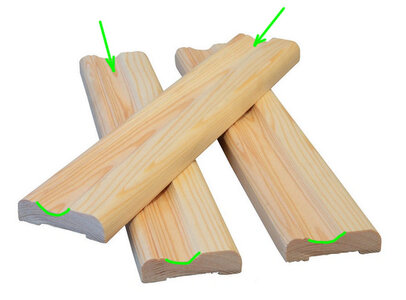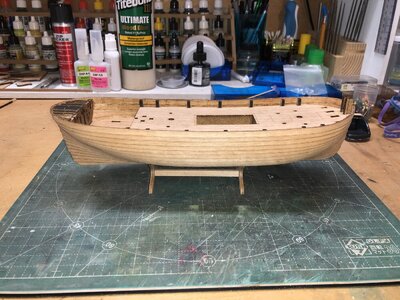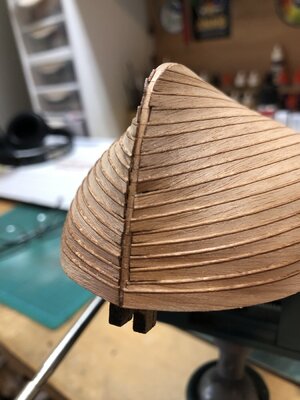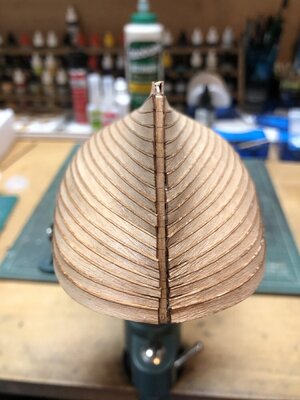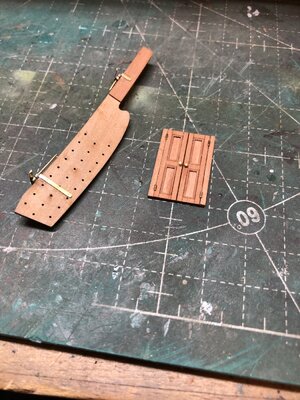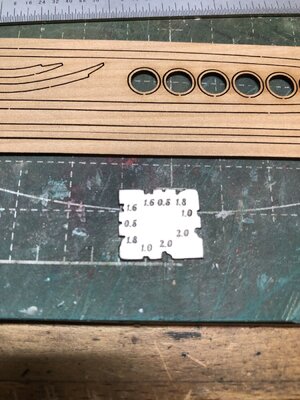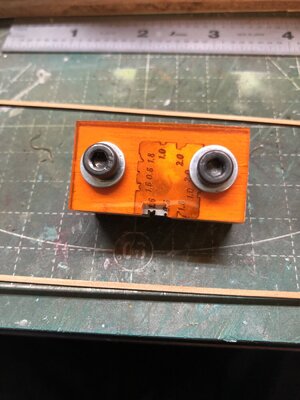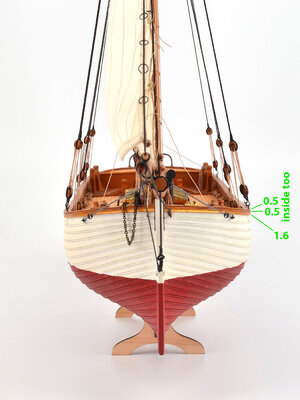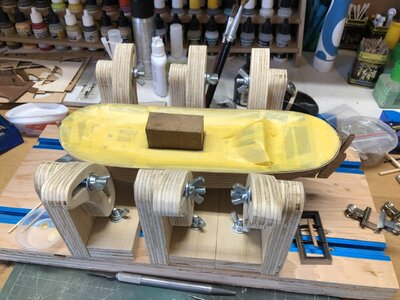- Joined
- Nov 4, 2021
- Messages
- 301
- Points
- 168

I'm really leaving my comfort zone starting a build log because 1) I've never done a build log, 2) I've never been able to complete any wooden ship ever started (other than some small boats in the novice category), 3) I expect to get chewed out a lot for not using the right terminology for parts and processes, and 4) this is probably more for my benefit than anyone else's as I can see I'm going to need a lot of help with this. With that said, part of my motivation for doing this build log is to share what I learn of this kit as I go along because I gather not too many have tackled this relatively new offering.
My first observation about this kit is that the fit of the parts so far has been, with few exceptions, excellent. The laser etched fairing lines on the bulkheads really are a great help. Laser etching part numbers into the larger parts would have also been a great help, especially since some parts are mislabeled (In the instructions there is a part A10 on each of the plates labeled "Plate A (part1)" but one of them is really A11. I will also say the instructions are pretty sparse for words, and it takes a great deal of studying the pictures, referencing back and forth, and imagination to figure out what one is really meant to do--I suspect having more experience than I have with ship building would mitigate much of that--but so far I'm figuring things out without any irretrievable errors that I have detected.
Assembling the bulkheads went pretty quickly due to the precise fit. Ran into a snag in step 3 when I discovered parts A30R and A30L were much taller than they appeared in the assembly instructions:
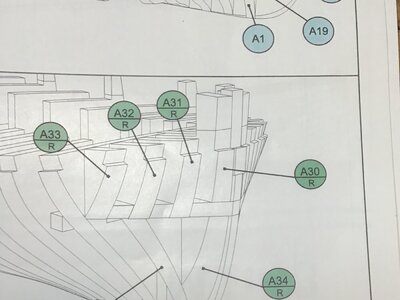
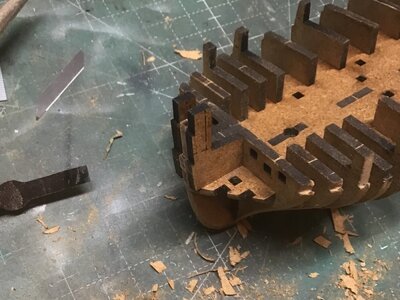
It was only as I got ready to start planking that I realized that those parts, like all the stanchions on the bulkheads, get cut of flush with the sub-deck once the wales go on. Problem solved, but it was a head-scratcher for a while.
The next surprise came as I started working on the wales which, along with the sub-deck and a few other parts come from plate C. Since these need to follow fairly substantial curves around the bow and stern I figured they would be a good place to try my hand at plank-bending. It was at that point I discovered plate C is not actually a solid 1mm piece of wood, but two 0.5mm sheets laminated together like plywood (but with the grain of both pieces aligned with one another). The moisture and heat of trying to bend these parts caused them to delaminate, requiring me to glue them back together again and let that sit until the glue dried before I could mount them.
In steps A5 and A6, you assemble two bulkhead assemblies, which if you are paying careful attention in step 8, you realize are just there to help form the wales and do not get glued to the hull. Subassembly 5 has two tabs that fit into two slots in the sub-deck, which is a somewhat loose fit, and as I moved the model around working on the planking the it kept falling out. Solution: drilled a couple holes through the tabs right underneath the sub-deck and inserted a couple of pieces of toothpick. Rock solid now, but easily removed when the time comes.
Hopefully some progress photos next time.
My first observation about this kit is that the fit of the parts so far has been, with few exceptions, excellent. The laser etched fairing lines on the bulkheads really are a great help. Laser etching part numbers into the larger parts would have also been a great help, especially since some parts are mislabeled (In the instructions there is a part A10 on each of the plates labeled "Plate A (part1)" but one of them is really A11. I will also say the instructions are pretty sparse for words, and it takes a great deal of studying the pictures, referencing back and forth, and imagination to figure out what one is really meant to do--I suspect having more experience than I have with ship building would mitigate much of that--but so far I'm figuring things out without any irretrievable errors that I have detected.
Assembling the bulkheads went pretty quickly due to the precise fit. Ran into a snag in step 3 when I discovered parts A30R and A30L were much taller than they appeared in the assembly instructions:


It was only as I got ready to start planking that I realized that those parts, like all the stanchions on the bulkheads, get cut of flush with the sub-deck once the wales go on. Problem solved, but it was a head-scratcher for a while.
The next surprise came as I started working on the wales which, along with the sub-deck and a few other parts come from plate C. Since these need to follow fairly substantial curves around the bow and stern I figured they would be a good place to try my hand at plank-bending. It was at that point I discovered plate C is not actually a solid 1mm piece of wood, but two 0.5mm sheets laminated together like plywood (but with the grain of both pieces aligned with one another). The moisture and heat of trying to bend these parts caused them to delaminate, requiring me to glue them back together again and let that sit until the glue dried before I could mount them.
In steps A5 and A6, you assemble two bulkhead assemblies, which if you are paying careful attention in step 8, you realize are just there to help form the wales and do not get glued to the hull. Subassembly 5 has two tabs that fit into two slots in the sub-deck, which is a somewhat loose fit, and as I moved the model around working on the planking the it kept falling out. Solution: drilled a couple holes through the tabs right underneath the sub-deck and inserted a couple of pieces of toothpick. Rock solid now, but easily removed when the time comes.
Hopefully some progress photos next time.
Last edited:



